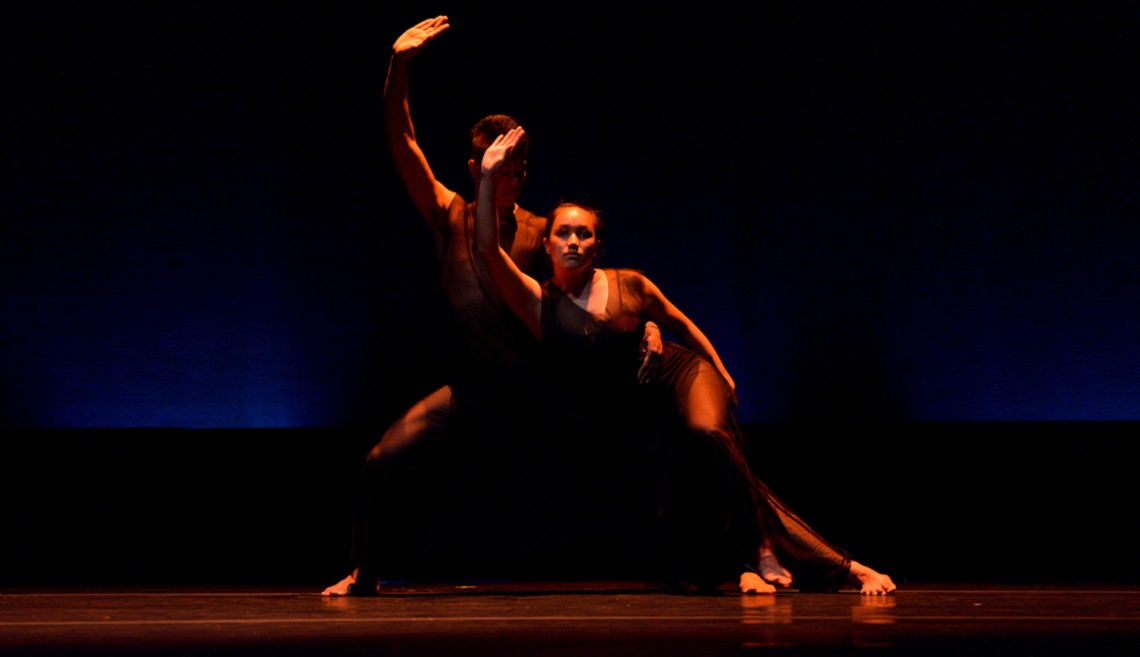 Alvaro Ponce
Alvaro Ponce
Stanford Dancers Take DC
Twilight Composite has truly been the little engine that could. When we began the rehearsal process for Diane Frank’s new dance work last September, neither I nor the six other student dancers could imagine the unbelievable adventure that it would take us on. We expected our one and only performance of the work to be at a regional conference in Modesto, CA, at the beginning of March. Yet last Saturday, May 27, we danced on stage at the Kennedy Center in Washington, D.C., having achieved national recognition.
This year, over 6,000 students from 364 institutions performed works at 11 regional conferences of the American College Dance Festival (ACDF). Only 30 of those dance works – one or two per region – were selected to perform at the National College Dance Festival (NCDF) in Washington, D.C. Held every other year, NCDF consists of three programs, each of which is performed twice at the Kennedy Center.
Twilight Composite has truly been the little engine that could.
Twilight Composite was one of the lucky few. After attending the ACDF West conference at Modesto Junior College (read more about the trip here), the Cunningham-inspired work by Dance Division faculty member Diane Frank was chosen to move on to the national level.

Alvaro Ponce
We arrived in Washington on Wednesday. Since we were assigned to perform on Saturday, we spent Thursday recovering from the jetlag and sightseeing. Naturally, we took dance photos everywhere we went.
Friday morning kicked off with rehearsal onstage at the Kennedy Center. The building is overflowing with history, its backstage halls lined with posters from past visiting artists. In the dressing rooms, the insides of the drawers are covered with messages from the thousands of performers that have sat at the makeup stations over the years.
We performed twice on Saturday, in spite of a minor mishap which landed one of our dancers, Julia, in the emergency room for stitches in her knee on Friday night. Julia had flown back from Paris where she is currently studying abroad in order to preserve the original cast of Twilight Composite for NCDF. In a true demonstration of a “the show must go on” mentality, she was a trooper and managed to perform despite the injury.
Of the seven stages at the Kennedy Center, we performed at the Terrace Theater. Although the stage floor was only about half the size of Roble Gym’s Studio 38 (and more slippery!), it was exciting to perform the piece in a fully-equipped, traditional proscenium theater. Our evening performance felt stronger than the matinee, in part because we were still adjusting to the stage space during the first show. However, both ran without any significant errors and, since the parents of a few of the cast members were able to attend performances, it was nice to finally get to perform Twilight Composite for friends and family.
In addition to performing and sightseeing, we had the opportunity to attend the other two programs and see the range of works that the adjudicators had selected from the ten other regional conferences. It was quite a diverse collection! Among the dances chosen were a 24-person Ballet Folklorico piece, a tap solo, a piece en pointe focused around the concept of rhizomes, and an all-male dance by Stanford graduate Carl Flink. The excitement and inspiration that came with exposure to work being created by my contemporaries at other schools at the regional conference in Modesto was compounded in Washington.
For me and many of the other Twilight Composite dancers, the performances at the Kennedy Center marked our last performances as Stanford students. Though bittersweet, I cannot think of a better way to end my Stanford dance career. I thank our fearless leader, Diane Frank, not only for choreographing the outstanding work, but also for soliciting the funds necessary to make the NCDF trip a reality.
This has been a major moment for Stanford Dance and I hope that the university begins to recognize the dedication of its student dancers and passionate Dance Division faculty. It should be noted that Stanford was one of the few schools at NCDF that does not offer a dance-related degree (the Division offers only a minor through the Drama Department), which speaks volumes about the commitment and capabilities of the Stanford Dance students and faculty. The dancers of Twilight Composite are among those who pursue dance at Stanford with the same rigor (if not more!) as their official majors. We are not a “team” or a “company”, even though we may share many of the same characteristics of such institutionalized groups. We are a family – and one that I feel incredibly grateful to have been a part of.
“I look forward to an America which will reward achievement in the arts as we regard achievement in business or statecraft. I look forward to an America which will steadily raise the standards of artistic accomplishment and which will steadily enlarge cultural opportunities for all of our citizens. And I look forward to an America which commands respect throughout the world not only for its strength but for its civilizations as well.” –John F. Kennedy
Katherine Disenhof (’12, Human Biology/Dance minor), a self-professed dance nerd who practically lives at Roble Gym, was a 2010-2011 Artist Fellow with the Institute for Diversity in the Arts, Summer 2011 Community Arts Fellow, and is currently a Student Arts Intern at Stanford Arts Institute.
